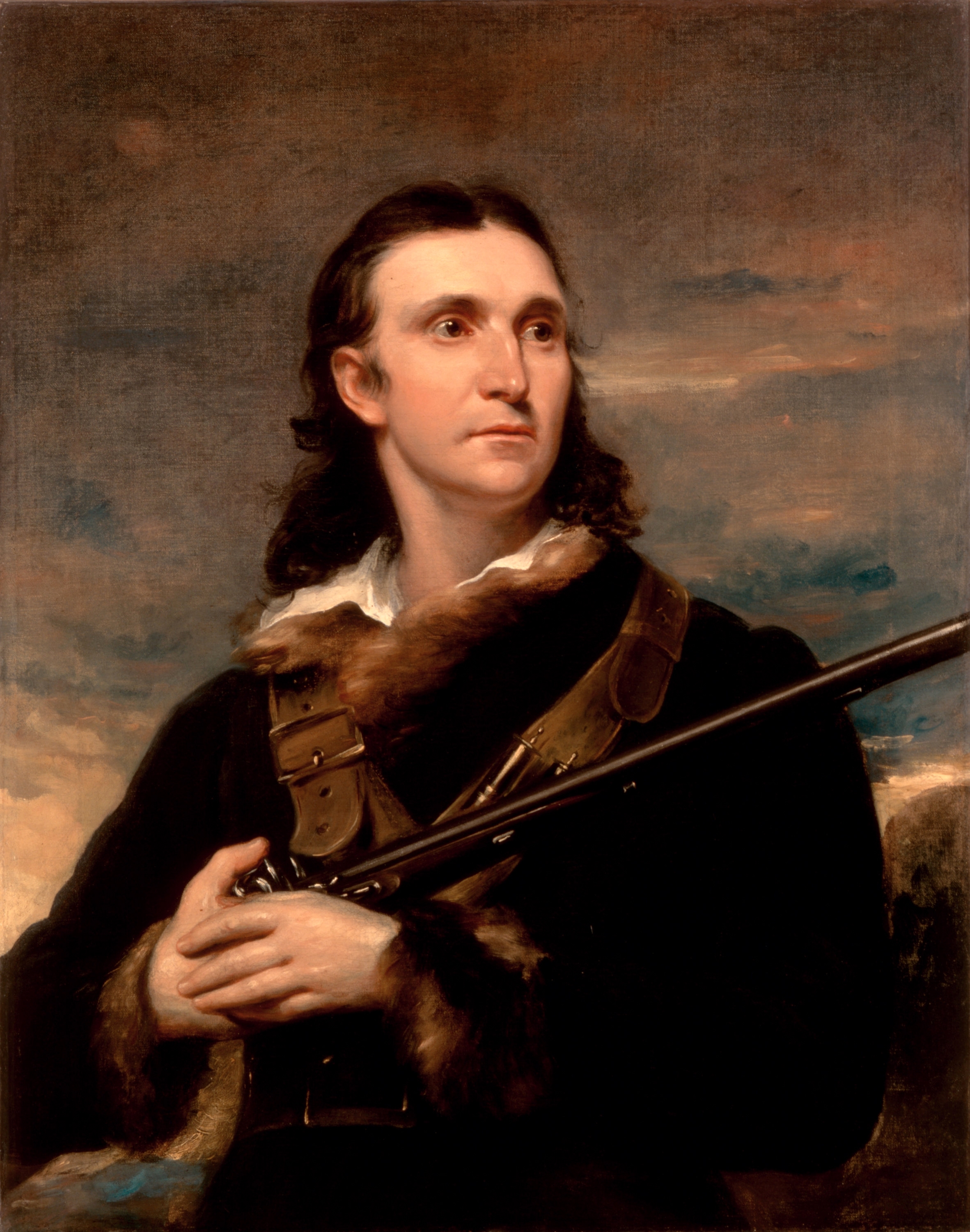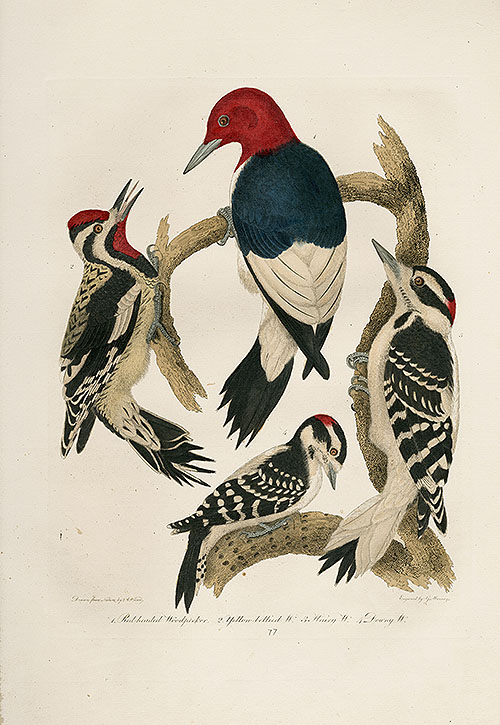Audubon:
 |
| Audubon's Whooping Crane (Grus americana) |
Despite these setbacks, Audubon's successes far outweighed any that would have dragged him down in his time. Before he even considered creating his own book on the birds of his adopted country, he conducted the world's first bird banding experiment by tying silver threads to the legs of a pair of Eastern Phoebes (Sayornis phoebe) that nested on the eaves of his outbuildings at Mill Grove. Through this observation he determined that the small birds that left the area during the fall and returned in the spring were actually traveling somewhere else entirely. He also discovered and described several dozen new species including many he named for his subscribers, supporters, and fellow naturalists. What was probably his most recognized power was his ability to pose and portray the birds he killed. While it was unfortunate that he needed to do so, it was a keystone of his time and without a good gun and eye for detail, he wouldn't have been able to procure the specimens necessary for his grand project. By posing them using a combination of thread, pins, and light wire, he managed to portray them in not only a life like manner, but it also allowed him to pose them in the dramatic scenes that made his work famous worldwide.
It was those paintings that would not only make him famous in his lifetime, but would cement him forever as having an artistic and natural love for birds. His work has been regarded as the spark for many bird artists after him and even inspired the creation of a society (or several if you're pedantic) dedicated to the protection of birds and their habitats. Many towns, parks, and sanctuaries also owe their names to this man's legacy. Ultimately, it was Audubon's own perseverance and drive that allowed him to transcend his own time and touch so many future lives with his artistic genius, personal observations, and own intriguing, winding, and amazing personal history.
Pros:
- Conducted the first bird banding experiments by using silver thread on a pair of Eastern Phoebes that were nesting on the eaves of his outbuildings (1)
- He posed and painted his own collected specimens of birds native to North America using watercolor, chalk, and pencil (1)
- He was inspired by Wilson's work to create a book of his own on the birds of America (1)
- He found fame in England, Scotland, France, and eventually in his adopted country of America by promoting his bird art to the higher classes and royalty of the day (1)
- Artistically gifted and had an excellent eye for detail in portraying his varied subjects (1)
- Discovered and described several new species of birds (1)
- He has a far reaching legacy as a bird artist, naturalist, and ornithologist in modern times (1)
- The National Audubon Society, Mass Audubon, and other state Audubon societies chose to name themselves after him because of his popular depictions of the nations birds (1)
- Several dozen towns, parks, and sanctuaries are also named after him and his influential work (1)
- Killed most of the birds used in his art using a gun, but on one occasion, tried to smoke a Golden Eagle (Aquila chrysaetos) to try and avoid damaging its plumage. He dispatched it instead after inserting a red hot poker into its heart (-1.5)
- He cribbed and plagiarized the notes and a few of the early drawings of Wilson and passed them off as his own despite having hid this fact quite poorly (-1)
- He portrayed several species that with further inquiry could have been determined that they were not native to North America (-.5)
 |
| Wilson's Whooping Crane and Co. |
Despite being regarded as the "father of American Ornithology" at a time when each new species discovered meant another piece to this huge and still mysterious American continent was uncovered, Alexander Wilson will always be in the shadow of John James Audubon. It's no fault of his own. It's not hard to believe that he wouldn't have been able to beat the celebrity of a man who constantly reinvented his past and image to sell his dream, but ultimately he, while having discovered so much, couldn't capture the imagination of the public with his portraits of North America's birds. It wasn't for lack of trying though.
After having been down on his luck for so long, getting his lucky break with Bartram and the Academy of Natural Sciences allowed him to pursue his love of birds to the end of his days. His overwhelming zeal and drive took him to many far away and seldom explored corners of the new United States and while, like Audubon, he had to shoot birds to secure his specimens, he made great use of them. He was a true scientist and studied the habits, food preferences, range, and appearance of all species he came across. Like Audubon, he discovered several new species and described them in his own book entitled American Ornithology, a massive nine volume work that had to be completed by his supporters after his death. Five species were named for him which includes Wilson's Snipe (Gallinago delicata), Wilson's Warbler (Cardellina pusilla), Wilson's Phalarope (Phalaropus tricolor), Wilson's Storm-Petrel (Oceanites oceanicus), and Wilson's Plover (Charadrius wilsonia), as well as, the now defunct warbler genus Wilsonia. He is remembered by the scientific community through the Wilson Ornithological Society and their ornithological journal entitled The Wilson Journal of Ornithology.
While never gaining much public popularity, his importance to the scientific community is apparent when comparing his achievements to Audubon. Without Wilson, Audubon would have had a significantly harder time of trying to make his way in the world of ornithology. Without Wilson's initial notes and observations to read and copy from, Audubon might not have gotten the data he needed to start his own project. Perhaps most notably without Wilson's initial contact with him in Louisville, Audubon might not have been inspired to try and produce his own version of a book on the birds of his adopted country. Arguably, without those early influences, Audubon might never have rose to any particular prominence. However, the main difficulty I have with that argument is that without the constant building upon old ideas of the old guard, you won't get anywhere. It was commonplace during Wilson's time that ideas would be outright plagiarized from other authors almost word for word and while some of his supporters were no doubt eagle-eyed enough to notice when Audubon did it to Wilson, no doubt when Wilson was starting out he probably lifted information from somewhere as well. Despite this tortuous history as rivals and contemporaries, hopefully it will come to pass that Wilson will gain more notoriety and fame for his contributions to ornithological history and come out of the long shadow left by Audubon.
Pros:
- He wrote and illustrated his own book series on the birds of America after teaching himself to draw and paint (1)
- His drive to create this book generated a huge amount of support from the scientific community in Philadelphia, culminating in his advancement into the Academy of Natural Sciences (1)
- He explored many new places to gather specimens for his book series (1)
- Discovered over two dozen new species of birds (1)
- He had several species of birds, as well as the now defunct warbler genus Wilsonia, named after him (1)
- An organization called the Wilson Ornithological Society and its journal take their name from Wilson (1)
- Shot the birds he needed for his paintings (-1)
- Drew the birds in his book in a stiff and almost comical manner (-.5)
Regardless, it's time to determine which of these two American Masters will advance to the next round.
Audubon (6) / Wilson (4.5)
 |
| The winner is John James Audubon |
Looks like Audubon advances to the next round! The next contest will be between the "Bird Man of India", Salim Ali and the "Hawk of Mercy", Rosalie Edge! Stay tuned for this next intriguing match up!



